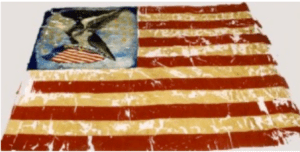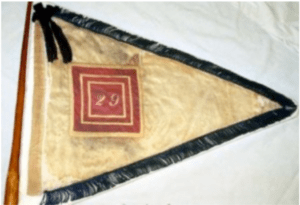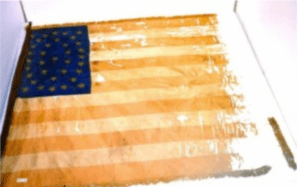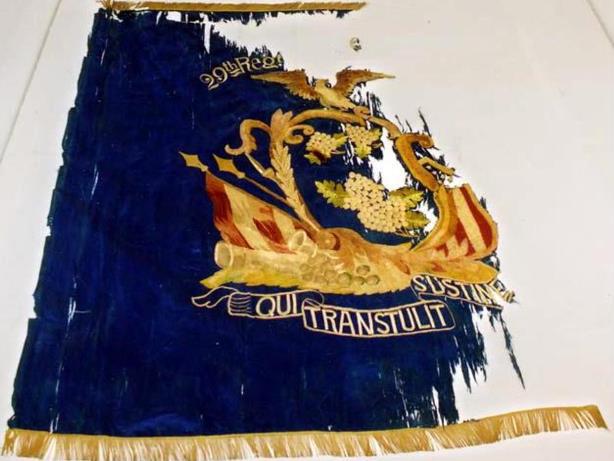By Cornel Garfman, MS
Writer and Historian
Information in this article was originally published as part of a semester-long graduate student project at Central Connecticut State University that examined Civil War monuments and their histories in and around the State Capitol in Hartford. Portions were extracted for use in the 29th Connecticut Colored Regiment history.
During the Civil War, battle flags were so important to soldiers, men would routinely risk their lives so that their unit banner would not be captured by the enemy. Because they represented a unit’s home state, soldiers took great pride in regimental battle flags and treated them with great reverence. Flags, which were carried by a designated team known as the color guard, also marked the position of the regiment on the battlefield. A typical regimental color guard would consist of two color bearers, one carrying a US or Confederate flag, often referred to as a unit’s “national” colors, and one carrying the state, or “regimental,” flag.
Considered a great honor, being in a color guard required a soldier to be extraordinarily brave, as the enemy often aimed their guns at an opposing army’s regimental flags. Consequently, the mortality rate of color bearers was quite high and there are countless stories of them being wounded or killed. After the war, most state governments put a great deal of effort into collecting and maintaining their battle flags, and although they were looked upon with great veneration well into the 20th century, these collections have been largely forgotten in modern times. Yet, state battle flag collections still exist, and with 110 flags, Connecticut owns one of the grandest assortments of military banners in the nation. Among them is a particularly unique flag display dedicated to the state’s first black military unit.
Of the nearly 200,000 black soldiers who fought for the Union in the Civil War, most were assigned to a portion of the US Army created to oversee all African American regiments, known as the United States Colored Troops (USCT). Four black regiments (three in Massachusetts, including the famed 54th immortalized in the film Glory, and Connecticut’s 29th (Colored) Volunteer Infantry (CVI)) retained their original state designations throughout the war.

Comprised of ten companies totaling approximately 1,000 men, the 29th CVI (Colored Volunteer Infantry) was presented with its first battle flag, a 33-star US banner, by a local minister, the Reverend Dr. Mott, on March 8, 1864, in the Fair Haven section of New Haven. The men made no show of emotion during the formal ceremony, recalled Isaac J. Hill in his book, A Sketch of the 29th Regiment of the Connecticut Colored Troops, “on account of the Regiment not receiving the $75 which was promised to them at their enlistment.” A little over a week later, on March 19, the New Haven Daily Palladium reported that a local black woman presented to the unit its second battle flag—its regimental colors. As the dark blue silk flag was handed over to the unit’s new commander, Colonel William B. Wooster of Derby, the father of one of the unit’s officers, the Reverend Dr. Leonard Bacon, gave a long and passionate speech in which he told the soldiers, “We give you this flag to march under which tells you that you are a Connecticut regiment, and it is our confident expectation that you as a regiment will do honor to the State of Connecticut, as well as to the stars and stripes. And in order to do this, you must bring back this flag when you return, without any dishonor.” Bacon concluded by reminding the 1,005 soldiers that as men of color, they would need to prove “worthy of the respect of fellow men,” in particular, whites. Immediately following the ceremony, as the regiment marched towards the wharf where the steamship Warrior was waiting to take them to the front, the soldiers could be heard shouting, “We’ll show you we can fight! We’ll show you that we are men!”
According to unit biographer Diana Ross McCain, during its course of service, the 29th suffered nearly 500 casualties in a half-dozen battles in Virginia.

Throughout the war, in addition to the two flags presented in March of 1864, the regiment also carried two small, white triangular flags, each displaying the unit’s number. These flags, known as guidons, were carried into battle on hand-carved wooden staffs on the left and right flanks of the regiment. It is unknown how or when the unit came into possession of these two flags, but when they were discovered in the mid-1980s, a small piece of black mourning cloth was found tied to one of the banners and is believed to have been placed there either in honor of men of the 29th killed in action or for President Abraham Lincoln.

The 29th (Colored) Regiment CVI 35-star US “National” flag was presented to the unit when it became part of the 25th Army Corps in March of 1865 – Courtesy of the Connecticut Office of Legislative Management, from the book Qui Transtulit Sustinet by Geraldine Caughman In March of 1865, just a few weeks before the end of the war, the regiment became part of the 25th Army Corps and received a second US flag, this time with 35 stars. At the ceremony, Colonel Ulysses Doubleday, 2nd Brigade Commander, praised the bravery of the 29th in his presentation speech, and according to unit historian Reverend Henry G. Marshall in History of the Twenty- ninth (Colored) Regiment Connecticut Volunteer Infantry; In Record of Service of Connecticut Men in the Army and Navy of the United States During the War of the Rebellion, companies C and G of the 29th became the first union infantry soldiers to enter the Confederate capital of Richmond, Virginia, when it fell on April 3, 1865. Later that same day, according to A. H. Newton in his book, Out of the Briars – An Autobiography and Sketch of the Twenty-Ninth Regiment Connecticut Volunteers, President Abraham Lincoln himself must have laid eyes on the 29th’s battle flags as he made a “triumphant entry into the city” to survey the scene, a mere twelve days before the commander in chief was killed by an assassin’s bullet.
After the Confederacy surrendered, the unit was shipped to Texas for several months to perform guard duty. Upon returning to Connecticut, the soldiers of the 29th were given a hearty welcome by Hartford Mayor Allyn S. Stillman, Connecticut Governor William A. Buckingham, and the state’s most celebrated Civil War soldier, General Joseph Roswell Hawley. The Hartford Courant reported that on November 25, 1865, the day the unit was discharged, Hawley applauded the soldiers (who were described as “slouching and weary- looking”) in particular, for their performance the year before while he served as their commander at the Battle of Darbytown Road, Virginia. Hawley closed his speech by saying that the men of the regiment deserved all rights and privileges afforded citizens of the country (although full citizenship for black Americans would not be realized for another three years with the passage of the Fourteenth Amendment).

